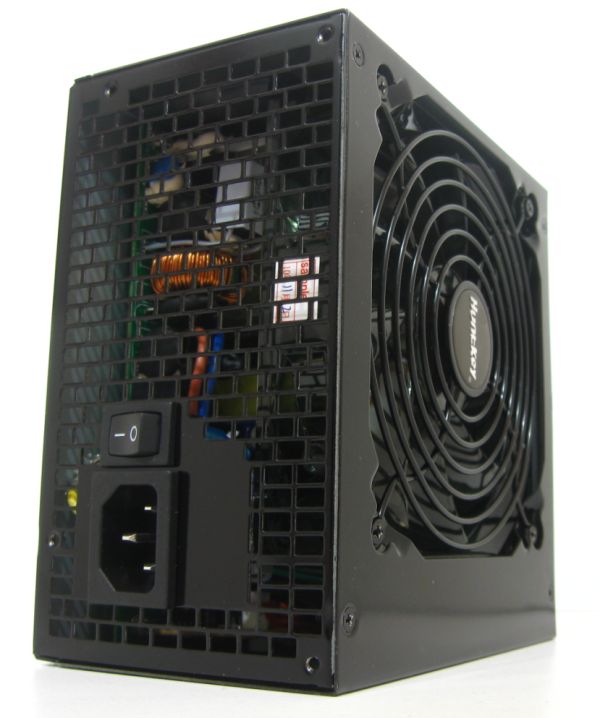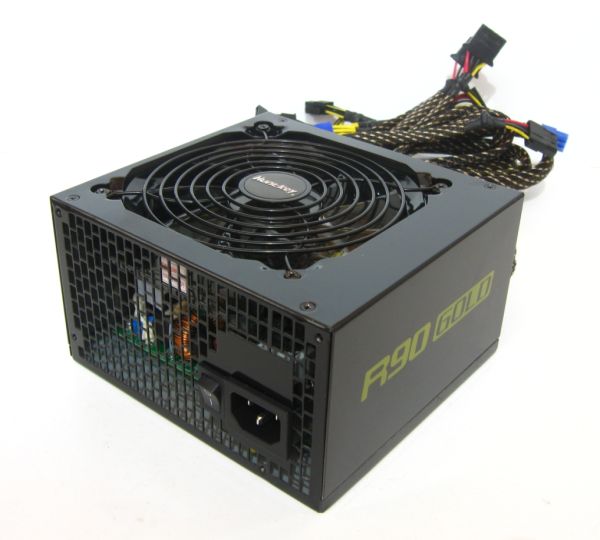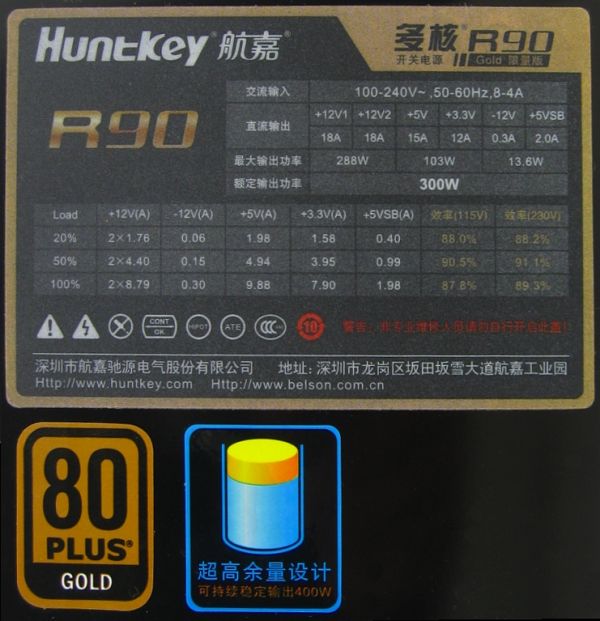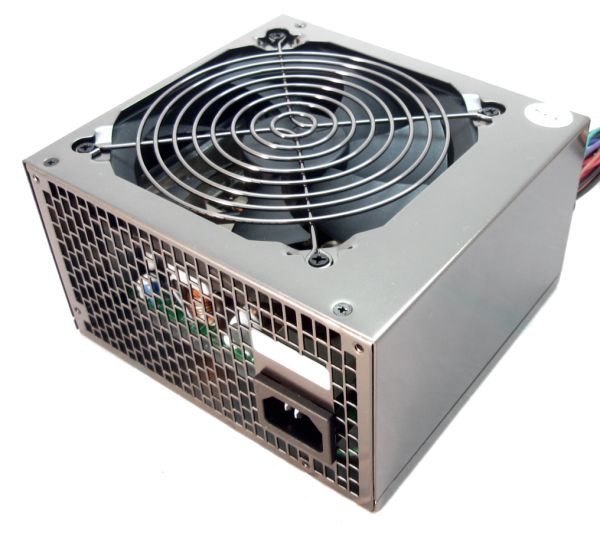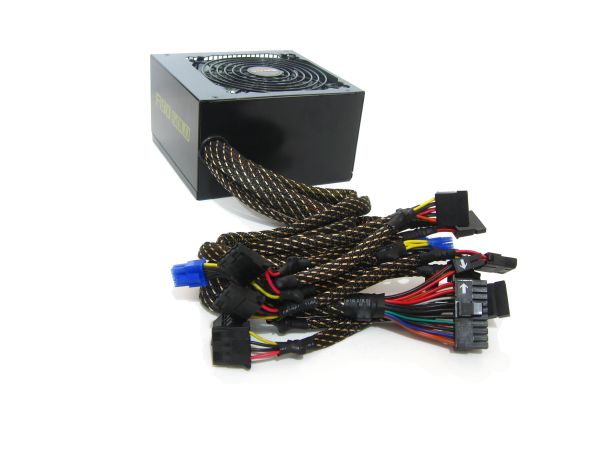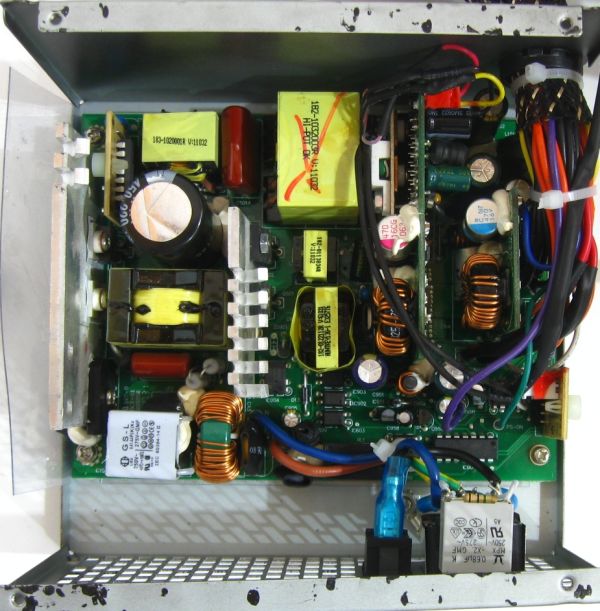
Original Link: https://www.anandtech.com/show/4069/huntkey-300w-80plus-gold
HuntKey Jumper/R90 300W 80Plus Gold
by Martin Kaffei on March 5, 2011 12:00 AM ESTHuntKey 300W with 80 Plus Gold
We recently received a new power supply from HuntKey dubbed the R90, or Jumper 300G for the western markets. It uses the HK400-52PP layout, which means the PSU is capable of delivering 400W at lower temperatures; however, the 300W rating is for 45C operation. The 300G is also one of the smaller PSUs with an 80 Plus Gold rating, making it an interesting option for HTPCs and average computers. But what about the price?
We don't have an exact figure for the US market yet, but materials and parts should cost less than half of what the Seasonic X-400FL requires, which means final pricing could be around $80-$90. One advantage the Jumper 300G has over the X-400FL is that it uses a native 400W design, where Seasonic is building off an 850W design. Since the 300G comes with a fan, it will obviously generate more noise than the fanless X-400FL, but the temperatures should also be lower. This could very well be the actively cooled alternative to Seasonic's X-400FL.
Unlike Seasonic, this is a fixed cable PSU. The HK400 is similar to what many OEMs might use, only with a retail box around it. HuntKey is quite proud of their design and promises very good performance. While we may not have a firm price yet, we can certainly check the voltage quality and other performance characteristics.
Internally, the unit uses a resonant circuit with ZVS (Zero Voltage Switching), active rectifying, and of course active PFC. While HuntKey sells many cheap power supplies in China, this is an example of the sort of quality they can achieve when they're not chasing the lowest price; we'll see more evidence of this with the capacitors on page four. HuntKey is also one of the first manufacturers to offer an 80 Plus Platinum certified PSU, but that's a topic for another day. The Jumper 300G (or R90) has plenty of reserve capacity, and HuntKey makes use of this by including two PCIe connectors: one 6-pin and one 6/8-pin, both on a single cable. That's a first for the 300W PSU market, and with such features HuntKey hopes to expand their presence in the Asian market.
Appearance and Specifications
Our review sample came without retail packaging, so we'll jump straight to the design and appearance. Above is the R90, with large rectangular cutouts for the rear ventilation. That's a standard HuntKey trait, as opposed to the hexagon/honeycomb ventilation used on many other PSUs. The R90 has a matte black finish, transparent fan blades, and cable sleeving that could easily be mistaken for something from Enermax. It's a decent looking, understated design and the case is only 14cm long.
Given the 80 Plus Gold certification, the use of DC-to-RC VRMs should be too surprising, but it's not something we typically see in the 300W market. Most of the power comes on the two +12V rails and we tested OCP at room temperature. OCP kicked in at 28A, which is definitely more than you'd normally get from a 300W PSU. However, the smaller rails can deliver up to around 100W for peripheral hardware and HDDs/SSDs; that means in typical PCs you'll have less than 28A on the +12V rail to work with (like all DC-to-DC PSUs).
That should still be sufficient for running a moderate midrange or lower GPU. HuntKey informs us that up to a single GeForce GTX 260 or 460 (and maybe even a 560 Ti if your CPU isn't too extreme) should work; on the AMD side, that equates to a single Radeon HD 5850 or 6950 or lower (and you might even manage a 6970 if your CPU isn't too demanding). Then again, erring on the side of caution might not be a bad idea, in which case the HD 6850 and GTS 450 would be a more reasonable limit.
The Jumper 300G has a slightly different appearance. Gone is the matte black exterior, replaced by a shiny silver casing. The cable sleeving is also missing, and the fan grille is different. Internally, the units are the same, but the American market will be getting this rather vanilla looking version.
Cables and Connectors
As mentioned before, the R90 has cable sleeving like Enermax. Both PCIe connectors are bright blue, making them easy to spot. The fan grille sits flush with the rest of the casing, and in general the design looks decent. We'd prefer plain black cable sleeving, but there's nothing horribly wrong with the current setup.
| Cables and Connectors | ||
| Fixed | Main | 24-pin 45cm |
| ATX12V/EPS12V | 4+4-pin 45cm | |
| PCIe | 6-pin + 6/8-pin 45-60cm | |
| Peripheral | 3x SATA + 1x PATA 45-90cm | |
| 3x PATA + 1x SATA 45-90cm | ||
Considering this is only a 300W PSU, it's not too surprising that some of the cables are a bit short. The main 24-pin connector should be long enough for most cases, but the 4+4-pin one could use a bit more length, especially if you try to use this in a case with a bottom-mounted PSU. The two PEG connectors are nice, even if they are both on one cable. In addition there are two peripheral cables with four SATA and four Molex connectors. Some users might miss the FDD connector, and considering the price it would be nice to at least get an adapter in the package, but thankfully we're mostly done with floppy drives these days.
Internals and Components
The first thing to note when looking at the internals are the three very thin and small heatsinks. That might be cause for concern in larger power supplies, but with the high efficiency there shouldn't be a lot of heat lost inside the PSU. The Gold certification requires at least 87% efficiency at 100% load, which would work out to at most 45W of internal heat loss. With the 120mm fan blowing on the components, things should be fine.
Looking at the power circuitry, starting at the input. Four Y- and two X-capacitors, one relay to handle current in-rush, current-compensated and linear chokes, and an MOV are all part of the EMI filtering. After that, HuntKey uses a common 10A bridge rectifier in a KBU housing. The PFC choke has its own plastic case, which is nice to see. Like Seasonic, HuntKey has different ICs for PWM and PFC. There's a CM6901X for switch control, which is physically in the secondary circuit. That's why they need the separate CM6502SX for PFC; most manufacturers combine both functions in one IC.There are two IRFB3206PBF in the secondary for active rectifying. Another interesting detail is the diode in the power factor preregulator. It's a component from QSpeed with one of the lowest reverse recovery charges in the inexpensive price range--usually a problem with CCM.
The main capacitor is a Rubycon USG rated at 85C/2000h and 220 μF. Two MOSFETS from ST Mircoelectronics follow (fully isolated TO-220FP casing), with a resonant topology and very efficient transformers. After rectification HuntKey has two DC-to-DC VRMs for +5V and +3.3V; both use all solid capacitors for filtering. The +12V rails also have plenty of solid capacitors, with a few liquid electrolyte caps as well.
This PSU has OVP on both sides, along with UVP, SCP, OCP, and OPP. It doesn't have OTP, but there's a diode for temperature measurements as part of the fan control. OCP worked fine in testing, tripping at 28A (336W).
There's not a lot of empty space on the PCB, the the PSU uses active cooling and an efficient design so that shouldn't be a problem; the 14cm casing could actually be shorter if HuntKey wanted. On the left is a large plastic piece to protect the PSU from short circuits caused by contact with external objects. Finally, the PCB uses first class material with good soldering. We've never seen this sort of quality in a retail 300W PSU before, so overall the internals are awesome!
Voltage Regulation and Quality
| +3.3V regulation | |
| Load | Voltage |
| 10% | +1.72% |
| 20% | +1.64% |
| 50% | +1.09% |
| 80% | +0.81% |
| 100% | +0.15% |
| 110% | +0.04% |
| +5V regulation | |
| Load | Voltage |
| 10% | +2.43% |
| 20% | +2.22% |
| 50% | +1.82% |
| 80% | +1.65% |
| 100% | +1.16% |
| 110% | +0.90% |
| +12V regulation | |
| Load | Voltage best/worst |
| 10% | +1.73% / +1.91% |
| 20% | +1.66% / +1.82% |
| 50% | +1.46% /+1.61% |
| 80% | +1.24% / +1.48% |
| 100% | +1.09% / +1.30% |
| 110% | +0.84% / +1.03% |
Results are measured under room temperature and 115 VAC. HuntKey has one of the best voltage regulation results out of all the high-end PSUs we've tested so far. The DC-to-DC VRMs are more than enough for the power levels listed on the label, so the voltage has low drops on +3.3V and +5V. Even +12V (V1/V2) is absolutely stable. Of course, the need to only handle 300W helps here. Some higher wattage PSUs with DC-to-DC have problems with ATX spec loads, since the VRM PCBs use almost the same dimensioning for their components.
Ripple and Noise
| +3.3V ripple quality | |
| Load | Ripple and noise |
| 10% | 2mV |
| 20% | 3mV |
| 50% | 4mV |
| 80% | 6mV |
| 100% | 9mV |
| 110% | 10mV |
| +5V ripple quality | |
| Load | Ripple and noise |
| 10% | 8mV |
| 20% | 10mV |
| 50% | 13mV |
| 80% | 17mV |
| 100% | 21mV |
| 110% | 23mV |
| +12V ripple quality (worst rail) | |
| Load | Ripple and noise |
| 10% | 19mV |
| 20% | 26mV |
| 50% | 30mV |
| 80% | 22mV |
| 100% | 26mV |
| 110% | 28mV |
+12V has the same problem as the first X-Series with relatively high ripple and noise results at low loads and lower results at high loads. Somewhere between these loads they change the switching type and frequency. Even so, the results are still very good and well within specification. Moreover, most manufacturers don't care about the "unimportant" 3.3V rail, but HuntKey has no more than 10 mV ripple there. Even if it's not the most important rail these days, we appreciate the attention to detail.
Noise, Efficiency, and Power Factor
| Sound Pressure Level | |
| Load | dB(A) |
| 10% | 18 |
| 20% | 19 |
| 50% | 22 |
| 80% | 23 |
| 100% | 24 |
| 110% | 26 |
While the HuntKey 300W is audible at high loads, the 1200RPM fan isn't loud. In a typical PC with a closed case, this PSU will be quieter than most CPU, GPU, and chipset fans. If you're after absolute silence, Seasonic's X-400FL will be the better choice, but most users will be quite happy with the low noise from the Jumper 300G. At 10% load (i.e. for a low power HTPC), the fan rotates at less than 650RPM and reaches the limits of our noise monitoring equipment.
Efficiency and PFC
| 115VAC, 60Hz | ||
| Load | Efficiency | PFC |
| 10% | 85% | 0.973 |
| 20% | 88% | 0.975 |
| 50% | 90% | 0.983 |
| 80% | 89% | 0.985 |
| 100% | 87% | 0.986 |
| 110% | 86% | 0.987 |
As always, the power factor correction is high using 115VAC. In addition, this PSU is still more than 85% efficient at 10% load and reaches or exceeds Gold level at 20%, 50%, and 100% load. Efficiency drops a bit once you exceed 80% load, with the maximum result of 90.25% efficiency at 50% load.
A Great Product, HuntKey!
While it can be pretty easy to find 80Plus Silver power supplies with output ratings of 700W or more, finding such PSUs in sub-500W offerings is rare. Even if we drop the requirement to 80 Plus Bronze, Newegg as an example lists only 12 PSUs rated at 400W or less. Of those, five come from Seasonic, and the only 80 Plus Gold offering is the $130 X-400FL we've mentioned throughout this review. HuntKey looks to add a second with their R90 / Jumper 300G, and it's the first 300W 80 Plus Gold we've seen. Perhaps more importantly, it's already available in Japan for retail customers, not just OEMs. Unfortunately, those of us in the US and Europe will have to wait a bit longer, as HuntKey is still looking for distributors that are willing to carry this sort of product. Hopefully they can find them soon, as this is a very compelling power supply, particularly if they can match or exceed the current 7980 Yen ($96) price point. Let's recap.
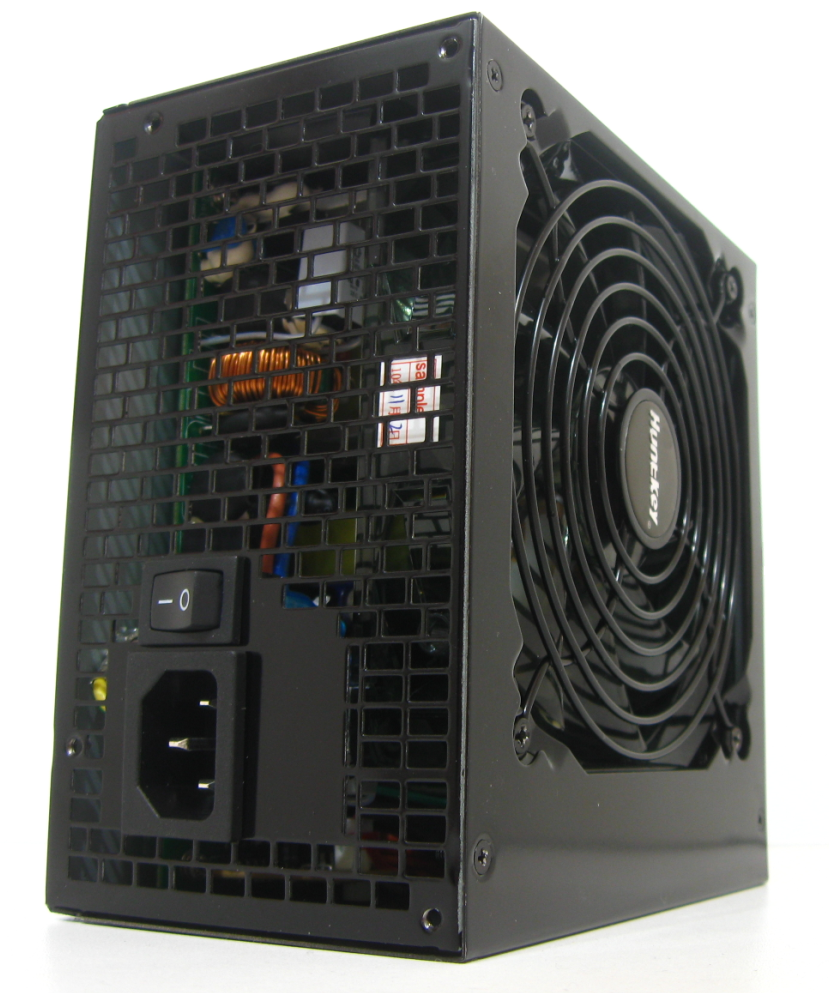
Starting with the cables and connectors, while it might be useful to have a longer ATX12V/EPS12V cable, the number of available connectors is outstanding. The R90 has two PCIe connectors (on one cable), along with two peripheral cables with four SATA and four Molex connectors. It might be nice to have a floppy Molex adapter, but you can buy one separately if you really need it--but shop locally, as shipping will probably be five times as much as the cost of the adapter! All told, there are enough connectors here to match most 500W PSUs, which is one more reason the expected price of ~$90 is acceptable.
Moving to the internals and overall build, the R90 / 300G has a good PCM, high quality capacitors, and a small high frequency transformer to save PCB space. This is one reason why the power of this design should not be underestimated. It's a strong PSU in a 14cm housing. In addition, HuntKey implemented all of the important safety functions on several ICs, and these features worked properly in testing. The high efficiency comes courtesy of the active rectifying, resonant topology, and well chosen MOSFETs with good characteristics. I've had a quick look at a SuperFlower PSU with almost the same quality, but it lacked OCP and used a cheaper material for the PCB. Right now, there really isn't anything comparable to this HuntKey model. Here's a recap of the performance to sum things up.
| HuntKey R90 (Jumper 300G) | |
| Features | Measurements |
| Active PFC | 0.973-0.987 |
| 80 Plus Gold | Up to 90% efficiency |
| High quality capacitors | Less than 0.50% ripple & noise |
| 1200RPM fan | No more than 26 dBA |
Our testing confirms that the R90 achieves the necessary marks for 80 Plus Gold certification, and efficiency is 85% even at a 30W load. The power factor is always above 0.90, though it's a bit lower if used on a 230VAC power grid. Ripple and noise are also well within specification, and the 3.3V rail in particular is virtually flawless; the 5V and both 12V rails are also good, with ripple less than half of the allowed maximum. Overall, we can't find any real points of criticism--even the appearance and cable sleeving are nice (though the 300G skips the sleeving).
We definitely look forward to seeing HuntKey's 90R / 300G in other markets outside of Japan, as this PSU would be perfect for HTPCs. The Seasonic X-400FL is still a viable alternative, though, depending on the pricing of the R90. Besides HTPCs, average PCs looking to "go green" and even gamers with moderate GPUs might be interested in this small, energy-saving PSU. HuntKey informs us that the GTX 460 (about the same as the HD 6950) are the maximum level of GPU they can support on this unit, and that's quite realistic, since +12V OCP is 28A. HuntKey's R90 is the sort of power supply we'd like to see more readily available, especially since the vast majority of PCs rarely need more than 200W (and often less than that). We'd give them an award, but we'll wait for more information on pricing and availability outside of Japan first.

